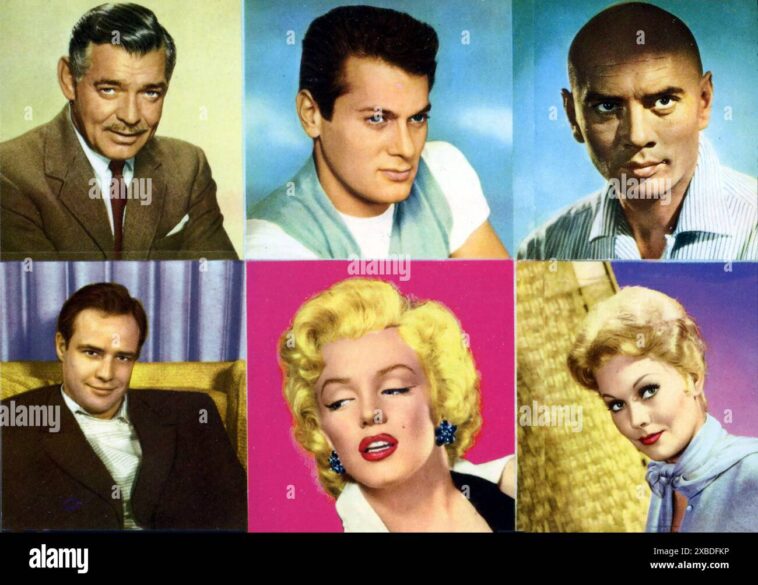The so-named Golden Hollywood Age stands out for its significance. The timeline, which began with the introduction of sound in films in 1927 up until 1969, bore witness to the rise of many luminous cinematic personalities. With World War II’s conclusion and the gradual disintegration of the studio system, more negotiating power switched to the actors and directors themselves. Not only was this shift financially beneficial for golden Hollywood personalities, but it also meant the true dawn of Hollywood franchises in the 1950s.
This decade saw a wave of unprecedented new talent, who adopted a more dedicated, and sometimes obsessive, approach towards acting. Their contribution not only transformed cinema but also began to shape societal norms. Who were these enigmatic individuals of the 1950s, stealing silver screen thunder with their performances? Here are some notable figures.
Kim Novak, renowned for her work in Alfred Hitchcock’s celebrated thriller ‘Vertigo’ in 1958, is a name to remember. Her career began with the modest role of an extra in ‘Son of Sinbad,’ but her star rose swiftly. Columbia Pictures once tagged her as the next Rita Hayworth. A line of successful projects followed, including the 1954 noir ‘Pushover,’ the romantic comedy ‘Phffft,’ the critically acclaimed ‘Picnic,’ and Otto Preminger’s acclaimed ‘The Man with the Golden Arm.’ However, Novak gradually became disenchanted with Hollywood, and by the 1960s, she chose an escape to other creative fields.
Then there was Jane Russell, known for her memorable performance opposite Marilyn Monroe in the 1953 sensation ‘Gentlemen Prefer Blondes.’ Further, the cinematic journey of Doris Day spanned a variety of genres and was nothing short of remarkable. She gave commendable performances in ‘Calamity Jane,’ a western musical in 1953, Alfred Hitchcock’s suspense thriller ‘The Man Who Knew Too Much’ in 1956, and the romantic comedy ‘Pillow Talk’ in 1959.
Meanwhile, Fred Astaire, whose popularity surged mostly between the 1930s and 1940s, made a strong comeback in the 1950s after retirement. He was part of the casts of ‘Royal Wedding’ in 1951, ‘The Band Wagon’ in 1953, ‘Daddy Long Legs’ in 1955, and ‘Funny Face’ in 1957.
Montgomery Clift was another remarkable star, counted among the early method actors like James Dean and Marlon Brando. He mastered his craft on-screen in the most unconventional and novel ways at the time. Similarly, Susan Hayward’s claim to fame in the 1950s came from her performances in dramatic films such as ‘With a Song in My Heart,’ ‘I’ll Cry Tomorrow,’ ‘The Conqueror,’ and ‘I Want to Live!’
Debbie Reynolds left an indelible mark at the start of the 1950s with hits like ‘Three Little Words’ and ‘Singin’ in the Rain.’ Cary Grant, on the other hand, experienced the highs of his career during the late 1930s and early 1940s. Although he hit a slump at the beginning of the 1950s, a reversal came when he starred alongside Grace Kelly in ‘To Catch a Thief.’
Ingrid Bergman’s acting prowess resulted in an impressive collection of awards that included three Oscars, two Emmys, a Tony, and four Golden Globes. She cemented her position in the hall of fame through films like ‘Casablanca,’ ‘Gaslight,’ and ‘Joan of Arc’ during the 1940s.
Elizabeth Taylor, who was Hollywood’s teenage queen during the 1940s, also left a profound impact on ’50s cinema. Rock Hudson emerged as one of the decade’s leading stars through his performances in ‘All That Heaven Allows,’ ‘Giant,’ and ‘Pillow Talk’.
John Wayne prolonged his stardom from the 1930s and 1940s into the 1950s, showcasing his maturity as a screen actor. Likewise, Charlton Heston, despite a less than stellar start in the first half of the 1950s, rose to prominence with films like ‘Dark City.’ He played Moses in ‘The Ten Commandments’ before ending the decade with another iconic role in the classic ‘Ben-Hur.’
The 1950s were defining years for Marlon Brando, highlighted by his unforgettable performances in ‘A Streetcar Named Desire’ in 1951, and ‘On The Waterfront’ in 1954. Similarly, James Stewart established his fame during the 1930s and 1940s by portraying affable and good-hearted characters — thus shaping the perceived American values – and continued to leave his mark on the 1950s.

